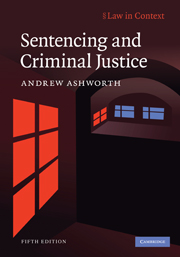Book contents
- Frontmatter
- Contents
- Preface
- Table of legislative measures
- Table of cases
- 1 An introduction to English sentencing
- 2 Sentencing and the constitution
- 3 Sentencing aims, principles and policies
- 4 Elements of proportionality
- 5 Aggravation and mitigation
- 6 Persistence, prevention and prediction
- 7 Equality before the law
- 8 Multiple offenders
- 9 Custodial sentencing
- 10 Non-custodial sentencing
- 11 Procedural issues and ancillary orders
- 12 Special sentencing powers
- 13 Conclusions
- Appendix: The Sentencing Council: provisions in the Coroners and Justice Act 2009
- References
- Index
13 - Conclusions
Published online by Cambridge University Press: 05 June 2012
- Frontmatter
- Contents
- Preface
- Table of legislative measures
- Table of cases
- 1 An introduction to English sentencing
- 2 Sentencing and the constitution
- 3 Sentencing aims, principles and policies
- 4 Elements of proportionality
- 5 Aggravation and mitigation
- 6 Persistence, prevention and prediction
- 7 Equality before the law
- 8 Multiple offenders
- 9 Custodial sentencing
- 10 Non-custodial sentencing
- 11 Procedural issues and ancillary orders
- 12 Special sentencing powers
- 13 Conclusions
- Appendix: The Sentencing Council: provisions in the Coroners and Justice Act 2009
- References
- Index
Summary
The purpose of this chapter is to draw together various themes emerging from the topics examined in the 12 substantive chapters, and to offer some concluding reflections. The chapter begins by returning to a fundamental issue, that of the role sentencing should be expected to fulfil in criminal justice. It then looks at the current sentencing framework and some of its shortcomings. This links to the third issue – the development of a sentencing guideline mechanism, its strengths and weaknesses. The fourth part of the chapter looks at the struggle between the proportionality principle and the increasing reliance on the rhetoric of protection and risk and the proliferation of preventive orders in sentencing. The fifth part reassesses the place of proportionality, and the challenges and uncertainties that surround its operation in the English system.
The responsibility of sentencing
There is no doubt that the task of sentencing imposes a great burden on magistrates and judges, and that many of them say that it is the hardest and most disturbing of judicial tasks. Given the momentous consequences it may have for offenders, in terms of deprivations or restrictions on liberty, that is as it should be. In the present context, however, a more significant question is what sentencers and sentencing should be held responsible for. Discussions of criminal justice sometimes appear to assume that sentencers are responsible for crime rates in society, or for the subsequent conduct of offenders, and these are the issues that need to be confronted.
- Type
- Chapter
- Information
- Sentencing and Criminal Justice , pp. 413 - 424Publisher: Cambridge University PressPrint publication year: 2010

